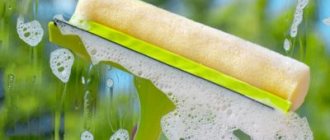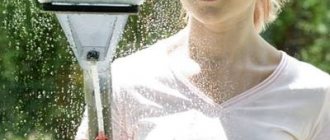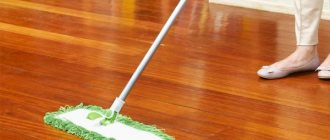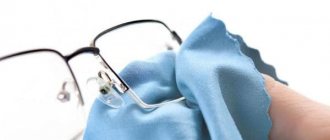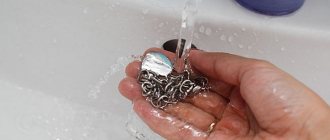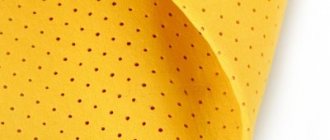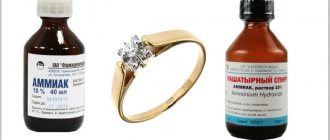Ammonia is one of the means of removing dirt and stains from various surfaces. With its help, you can also clean window glass efficiently - until it shines and without streaks.
To do this, you need to know exactly how to use the drug, and how best to prepare the most effective solution for glass.
In this article we will tell you whether and how to wash windows with ammonia.
How to wash windows and blinds with ammonia without streaks?
For a composition with ammonia to be effective, certain proportions must be observed.
- If the composition does not intend to use additional agents, then you need to dilute five drops of ammonia in five liters of water. The resulting mixture is thoroughly mixed.
- The composition can be improved. Glycerin is most often used for this. The following proportions are observed: add the same amount of glycerin and five ml of ammonia to 200 ml of water. The advantage of the composition is not only the thorough cleaning of the windows, but also the further protection of the plastic from spraying or the appearance of ice.
It is first necessary to remove all excess from the windows (blinds and sashes) to facilitate access to the glass. It is recommended to remove the largest areas of dirt, as well as dust and cobwebs using a mop or a special brush.
Windows are washed according to the following algorithm:
- Dip the sponge into the prepared solution, wring it out thoroughly and wipe first the frames, then the window sill and slopes.
- To clean hard-to-reach places, such as window hinges or sashes, use cotton swabs. They can be replaced with toothpicks and cotton wool.
- After this, take a new sponge (the old one is thoroughly washed in warm water). It is moistened in a solution of ammonia and the windows are wiped from top to bottom. This is necessary to ensure that there are no dirty areas left on the glass.
- Wipe the glass units dry using newspapers or paper. If you don't have them on hand, you can use a clean cloth, but polishing should only be done with dry materials. In this case, there will be no divorces left.
- At the last stage, we finish washing the remaining elements, including sashes or blinds.
It is advisable to repeat the procedure two or three times. This is necessary to ensure that the surface of the glass and all profiles are 100% clear of dirt. It is with the help of ammonia that it is possible to remove not only dirt from window frames, but also the yellowness that often forms on the surface of the plastic.
Spring is coming, and with it the desire for the sun to shine in all parts of the apartment. For this purpose, housewives open the curtains wider, but the light does not tend to penetrate into all corners of the apartment, because during the winter the windows have acquired a grayish tint and are covered with a layer of dust. If you want to get rid of it, there are a huge number of ways. We will talk about how to remove all contaminants using vinegar or ammonia.
In addition to ammonia, ordinary table vinegar does an excellent job of removing stains, which must be diluted with water in a ratio of 1 to 5. The liquid is sprayed on the glass, and then it is wiped dry with newspaper.
To ensure that there are no streaks left on the glass, use the following mixture: dissolve 2 teaspoons of vinegar in 1 liter of water.
In addition to glass at home, you can use vinegar to wash a mirror or car window. To do this, dilute a tablespoon in a one and a half liter bottle, put on a spray bottle and wet the surface generously.
If a housewife plans to quickly cope with such a task as washing windows, she must prepare and create all the conditions under which streaks will not remain on the glass. To do this, you need to acquire not only a good detergent, but also the right material to get rid of dirt. Half the success of this event depends on the correct equipment.
In order to properly clean the windows in your house, you need to stock up on foam sponges, a solution of ammonia, an additional container of water, old newspapers, soft rags and prepare a vacuum cleaner. It is best to work with gloves. You may need a chair or stepladder to reach the upper areas of the window.
In order for this process to be completed successfully and as quickly as possible, it is necessary to follow the sequence of actions.
First of all, you will need to thoroughly clean all window sills and window profiles. This is very important, and without carrying out this procedure you should not start washing the glass itself. First you need to remove the curtains or blinds and get rid of everything that is located on the windowsill. These items will interfere with the work process and may be damaged by water that gets on them.
Window washing always begins with a thorough cleaning of the frames and window sill. All movements are made from top to bottom. This will prevent dirt from spreading further over the surface and will save the worker’s effort. To begin with, you can treat the surface with a vacuum cleaner. This will help get rid of various cobwebs and unpleasant insects.
Next, you should proceed directly to washing the glass. This is the most difficult and responsible part of the work. First of all, the dirt needs to be washed off with a sponge. To do this, the foam rubber is well moistened in the solution prepared according to the second recipe. Windows need to be washed from top to bottom, this is very important. At the end of this process, it is necessary to polish the glass surface with a piece of soft cloth or newspaper. After treating the glass with ammonia, this process will occur very easily.
If the windows have blinds, they can also be washed with ammonia. This is not difficult to do, but for this procedure you will need an old but clean sock. It is put on the hand over the glove, moistened in the solution, and then each strip is grabbed and wiped. You can use another sock to wipe the blinds dry. This method is very effective for cleaning plastic light protection devices.
If your house has very high windows, it is best to clean them with a special mop. Such options are sold in any hardware store and are not very expensive. The mop tip is double-sided, which is very convenient. On one side there is a sponge attached, and on the other there is a rubber scraper, which is used to polish the surface.
Mops are equipped with long handles, which allows them to reach the most difficult to reach places. This device can be used when washing windows with a solution of ammonia, and with the use of factory detergents. The most convenient way is to take a spray bottle to apply the solutions to the glass, and then wipe everything with a sponge and scraper. It must be remembered that the spray gun only works in a vertical position.
Ammonia is one of the most effective and inexpensive means for high-quality cleaning of windows without streaks. This solution does its job better than many expensive advertised products.
If the smell of ammonia seems unbearable, you can try replacing it with another inexpensive product that has proven to be effective. This can be ordinary vinegar or a solution of potassium permanganate. All these means give good results with a minimum of cost and effort.
Ammonia is an aqueous solution of ammonia, a transparent liquid without color, but with a pungent odor. Its use is justified not only in the field of medicine, but also in everyday life. Many people recommend washing windows with ammonia - it helps dissolve complex stains and avoid streaks.
Many housewives have heard about the properties of ammonia as a detergent, however, not everyone knows how to use it correctly. But with its help you can significantly reduce the window cleaning time and reduce labor costs. Therefore, in this article I will tell you in detail how to wash windows with ammonia.
Ammonia allows you to quickly and easily clean windows
| Ingredients | Quantity |
| Ammonia | 5ml |
| Water | 5l |
In this case, ammonia is added to the water and mixed thoroughly. Despite the fact that this solution is extremely simple, it copes well with stains, not only on glass, but also on other surfaces.
Glycerin will improve the quality of the detergent
| Ingredients | Quantity |
| Water | 200 ml |
| Glycerol | 200 ml |
| Ammonia | 5 drops |
We suggest you familiarize yourself with How to clean floor tiles after renovation: tiles on the floor, primer for porcelain tiles, cleaning and how to wash.
This solution is prepared quite simply:
- first of all, you need to dilute glycerin in water in a one to one ratio;
- after this, add a few drops of ammonia to the composition and mix it thoroughly.
It should be noted that this solution not only copes well with dirt, but also protects the surface of the glass from icing in the winter. In addition, the thin film it forms on the surface prevents glass from becoming dirty.
Here, in fact, is all the information on how to dilute ammonia to prepare detergent. It should be noted that accuracy is not required in this case. It is only important to approximately follow the proportions.
In the photo - a window cleaning sponge
Before washing windows with ammonia, you need to prepare the following equipment:
- container into which the cleaning composition will be poured;
- foam sponge;
- newspapers;
- several soft cloths;
- latex gloves.
You may also need a stepladder or a stable chair to stand on to reach the top of the windows.
Window cleaning
The main stages of washing windows using ammonia
First of all, you need to wash the window frames
First of all, you need to clean and wash the window sill and profiles (window frames) with your own hands. You should not start cleaning glass without completing this procedure. The work is carried out in the following sequence:
- First you need to remove all objects located on the windowsill. In addition, curtains or blinds should be removed;
- then you need to remove dust from the frames and window sills. To do this, they can be vacuumed or wiped with a damp cloth;
- after this, the surface must be cleaned with a solution of ammonia in water to get rid of stubborn stains and other contaminants;
- At the end of the work, the solution should be washed off with a wet sponge and then wipe the surfaces with water.
Details
About the concentration of the solution
How to dilute ammonia for cleaning glass
Before you start washing windows, you need to prepare a solution of water and ammonia. There are several ways to do this. But before that, you need to prepare your inventory. You will need:
- container for preparing the solution;
- sponge;
- napkins or rags.
Ammonia has a strong, unpleasant odor, and even when used in minimal quantities, good ventilation must be provided.
How much ammonia to add when washing windows
The usual method is the simplest and to prepare such a solution you only need ammonia and water. Necessary:
— fill the container with water (5 liters);
- add 5 ml of ammonia to it;
- mix the components thoroughly.
Although the method of preparing the solution is very simple, it turns out to be very effective.
Supplements
Cleaning windows with glycerin and ammonia
This recipe helps prevent ice from forming. If this is your goal, then you will need an additional component in the form of glycerin. In addition, after using this solution, the glass will shine.
Glycerin does not have the ability to clean dirt and remove stains. It is added to the composition so that the glass acquires shine. A bonus to this is that glycerin helps prevent frost from appearing on windows in winter and dust from settling.
Instructions:
- - pour a glass of water into the container;
- - add 200 ml of glycerin;
- - pour 5 drops of ammonia;
- - mix everything thoroughly.
REFERENCE! After using this solution, less dust will settle on the glass.
Cleaning streak-free windows with ammonia
Before you start cleaning the glass, you should first prepare for this procedure. To do this you need:
- - remove all foreign objects from the window;
- - remove curtains, tulle;
- — in the presence of heavy contamination, you must first wash off the main dirt and dust. Remove cobwebs, wipe the glass with a damp or dry cloth.
Windows should be washed in the following order:
- Wash frames and slopes. This is done with any suitable solution, which includes ammonia solution. It is best to do this with a sponge or rag.
- Wash the glass using a sponge or rag. If the windows are high, you can use a special mop to reach all areas.
- It is necessary to wash off dirt from top to bottom so as not to smear dirt on the glass.
- Wipe the glass dry.
- Clean the blinds.
REFERENCE! A small amount of ammonia in cleaning solutions does not harm metal-plastic materials.
3 alternative ways
If for some reason you cannot use ammonia, then there are other means that give good results, which are available in every home. What they have in common is accessibility and good cleaning results after use.
Vinegar
Depending on how dirty the window is, you need to select the optimal concentration of the cleaning solution. The usual recipe is based on mixing 0.5 liters of water, 50 ml of vinegar and 0.5 tsp. dishwashing detergents.
This recipe can be used to remove dirt and stains well. After using this product, the glass begins to shine and there are no streaks on it.
Dentifrice
If the glass is too dirty, you need to use tooth powder or chalk.
Preparation of the product is based on mixing a liter of water with 50 grams of powder. The prepared solution must be applied to the glass and then cleaned with a napkin. Do this when the product dries a little.
REFERENCE! Heavily contaminated areas should be treated separately, using a more concentrated mixture of powder and water to obtain a paste.
Onion
A head of onion, cut into two halves, can help remove stains on glass. Onions can help get rid of streams, insect marks and other contaminants.
To make the stains disappear, rub the stains with a fresh onion cut. After this, the window should be washed in the usual way.
REFERENCE! The onion method is quite labor-intensive for cleaning the entire window, but it’s just right for getting rid of local dirt.
Recipes for detergents with ammonia
Ammonia is a solution containing ammonia. It has a sharp, specific smell that cannot be confused with anything else. Ammonia perfectly dissolves acids, for this reason it will not be difficult for it to deal with old contaminants. The most important thing is to correctly calculate the proportion and make the solution in accordance with all the rules.
Ammonia quickly dissolves acids, and therefore easily copes with stains on glass. But when washing, you need to correctly calculate the dosage.
The detergent is prepared from two components - ammonia and water. They are combined in a 1:1 ratio. The composition copes well with stains on glass and other surfaces.
General information
Features of use
Ammonia is an ammonia solution that has a strong unpleasant odor. One of the areas of its application is the removal of difficult-to-remove contaminants.
It is very effective, so it is added to household chemicals in factories. It is also added to glass and mirror cleaners.
The main feature of using ammonia is to take small dosages that should not be exceeded.
REFERENCE! Adding ammonia to the product provides it with good results and removes almost all types of contaminants.
Pros and cons of using ammonia
When using ammonia to prepare glass cleaning solutions, there are several advantages.
These include the following:
- - low cost;
- — efficiency of use;
- — ease of use;
- — availability — sold in any pharmacy;
- - economical consumption.
Among the disadvantages are:
- - unpleasant pungent odor;
- - Care must be taken when using it.
REFERENCE! Of course, the listed disadvantages may alarm someone, but you should not refuse to use this product because of them, since its effectiveness outweighs all the disadvantages.
Instructions on how to use ammonia for windows
Before you start washing the surface of the windows, you should find out in what proportions you should mix the necessary ingredients. Solutions should be prepared in various ways, each of which can easily remove old stains. We will present several options from which each housewife will choose exactly the one that suits her:
- Composition No. 1. You need to take 5 liters of water, then take 5 ml of ammonia and mix everything;
- Composition No. 2. Take 0.2 liters of water, then add 5 drops of ammonia and 0.5 liters of glycerin.
The latter composition differs in that after it the double-glazed windows become much less dirty, and in winter it provides additional protection against ice. In addition, the glass is given an unusual bluish tint.
Cleaning sequence
In order for this process to be completed successfully and as quickly as possible, it is necessary to follow the sequence of actions.
First of all, you will need to thoroughly clean all window sills and window profiles. This is very important, and without carrying out this procedure you should not start washing the glass itself. First you need to remove the curtains or blinds and get rid of everything that is located on the windowsill. These items will interfere with the work process and may be damaged by water that gets on them.
How to wash windows without streaks with products from the store?
To get maximum efficiency, you should wash your windows using a certain technology. All equipment should be prepared in advance so that you don’t have to run around the house with dirty hands and look for everything. Required list:
- Rubber gloves;
- A foam sponge that should be used to wash the structure;
- Chair;
- Container with the selected solution;
- Mop;
- Clean water;
- Vacuum cleaner;
- Soft cloths;
- Newspapers.
Those who want window cleaning to be a joy should do the cleaning according to the steps.
- First you should prepare your workplace - remove everything from the window sill and remove the curtains from the window;
- You should start washing by washing the window sill and double-glazed window frame;
- To do this, you need to clean the surface with a vacuum cleaner;
- Moisten a foam sponge in detergent and thoroughly wipe the frame, and then the window sill;
- Use a slightly damp cloth to remove excess soap suds;
- Next, everything should be treated with solution No. 1.
Window glass cleaning
- You should take a foam sponge and dip it into solution No. 2;
- Apply it to the entire surface of the glass from top to bottom;
- In order to polish window glass, you need to take newspapers or a soft cloth to help you.
Cleaning the blinds
Using any of the two solutions presented, it is possible to easily organize the washing of blinds.
- First the eye must be opened;
- Place the plates along the frame;
- Take a sock and dip it into the solution;
- For convenience, the sock is worn like a glove;
- Next, each plate is wiped on both sides and then wiped dry.
Many housewives have heard about the miraculous properties of ammonia when washing glass. However, not everyone knows how to wash windows with ammonia correctly so that there are no streaks.
Spring and warmth require the housewife to spend a lot of time on restoring what has fallen into disrepair over the winter. One of the main tasks is high-quality window cleaning. This will allow the sun's rays to penetrate every corner of the house and make it brighter, and the hostess's mood joyful.
However, to achieve a good result, you need to try. Many people know how much effort cleaning windows takes. It is especially difficult to get rid of stains on them, but many ways have been invented for this case. The most popular and economical in cost is washing windows with ammonia, which is diluted in water. In this simple way you can achieve an ideal result and quickly get rid of unpleasant dirt.
If the housewife wants to get rid of dirt on the windows without extra effort and hassle and at the same time spend a minimum of money from the family budget, you need to use the tips given below.
To tidy up the blinds, you need to open the window and place them parallel to the window frame. After this, a rag or sponge is dipped in the solution and each lamella is thoroughly wiped on both sides. Then the blinds are washed with warm water and wiped dry.
Ammonia helps to quickly and easily wash windows without streaks and smudges. A solution of ammonia can be used either independently, combined with water, or mixed with other products. This will make it possible to enhance the effect and cope with washing faster.
| Components | Quantity |
| Water | 200 ml |
| Glycerol | 200 ml |
| Ammonia | 5 drops |
- dilute glycerin in water in a ratio of 1:1;
- add a few drops of ammonia;
- mix everything thoroughly.
You can add a little ultramarine blue to the composition. It will give the glass a bluish tint.
The solution not only copes well with dirt, it protects the glass surface from icing in winter. A thin film formed on the surface prevents the deposition of dirt.
- container for detergent;
- foam sponge;
- newspapers;
- several soft cloths;
- latex gloves.
If the windows are high, then it is more convenient to clean them with a special mop. The mop tip is double-sided - on one side there is a sponge, on the other there is a rubber scraper that polishes surfaces. Mops have long handles, which allows you to reach hard-to-reach places. It is convenient to apply the solutions with a spray bottle and then wipe the glass with a sponge and scraper.
- the surface of the window sill is cleaned, curtains and blinds are removed;
- dust is wiped off from frames and window sills (with a vacuum cleaner or a damp cloth);
- the surface is cleaned with a solution of ammonia diluted in water;
- Rinse off the solution with a wet sponge and wipe the surface with water.
Then the glass is washed. The instructions for performing this work are as follows:
- Wash off the dirt with a sponge, dipping it in a liquid based on ammonia. It is necessary to wash from top to bottom, otherwise dirty streaks will remain.
- Dip the sponge into the solution, squeeze lightly, repeat the procedure until there are no stains or other contaminants left on the surface of the glass. A mop can be used to thoroughly clean hard-to-reach areas.
- Polish the surface of the glass with newspapers or a soft cloth.
If there is any detergent left, you can use it to shine glass objects - mirrors or furniture facades.
Add a quarter cup of vinegar to 2 cups of water and a half teaspoon of soap. Mix everything in a spray bottle.
We suggest you familiarize yourself with How to clean plastic windows from yellowness and dirt
From vinegar you can make an effective and safe “glass cleaning liquid” that cleans perfectly and does not leave streaks. To do this, you just need to dilute two teaspoons of vinegar in 1 liter of water.
Use a vinegar solution to clean mirrors, window glass and car windows: fill a 1.5-liter plastic bottle with water, add 1 tbsp. spoon of vinegar and put on the cap with a spray bottle.
Windows can be easily washed using ammonia or table vinegar diluted with water in a ratio of 1:5. The liquid can be sprayed on the glass, and then the glass can be cleaned with old newspapers. Windows should not be washed in direct sunlight.
Pour vinegar and warm water into a spray bottle in a one-to-one ratio. Spray the glass with this solution and wipe with old newspaper.
Thus, it is good to wash car windows - vinegar has a dust-repellent effect. To get rid of fingerprints and children's palms, wipe the glass with a solution of water and lemon juice (a tablespoon of juice per liter of water).
To do this, you can use a mixture of vinegar and water or lemon juice and water. Then wipe the glass with newspaper.
Pour vinegar and warm water into a spray bottle in a one-to-one ratio. Spray the glass with this solution and wipe with old newspaper. This is a good way to wash car windows - vinegar has a dust-repellent effect. To get rid of fingerprints and children's palms, wipe the glass with a solution of water and lemon juice (a tablespoon of juice per liter of water). Windows should not be washed in direct sunlight.
Remove cloudy deposits with a cloth moistened with ordinary table vinegar. After this, wash the glass with clean water and wipe dry with soft paper.
First wipe dirty glass with a soft cloth soaked in soapy water and lubricate it with a settled mixture of water and chalk (2 tablespoons per glass of water). When the glass is dry, wipe it thoroughly with a soft cotton cloth or newspaper.
Causes of cloudy glass:
- Very hot and windy weather. Due to direct sunlight, moisture evaporates very quickly, which is the cause of stains. It is precisely because of the high rate of moisture evaporation that you should not wash windows in windy weather.
- Wrong cleaning products chosen. That is, substances with abrasive particles often scratch glass, which causes clouding.
- Wrong technique. All dust must be removed initially. That is, carry out cleaning in several stages. Only after removing the layer of dust, the surface is washed using special products.
Stains on windows
Review and folk remedies:
- Dissolve 5 tablespoons of starch or crushed chalk in 3000 ml of water
- Add 4 tablespoons of laundry soap shavings to 2.5 liters of water.
- 120 g of lime dissolved in 3 liters of water
- 3 spoons of tooth powder are added to 2500 ml of water and stirred
Washing windows using traditional methods
Recipe:
- Pour 240 ml of water and 55 ml of regular vinegar into a saucepan. Add 5 ml dishwashing detergent and stir
- Pour the solution into a spray bottle and shake. Remove dust with a dry towel or brush
- Now use a spray bottle to apply the product to the glass. Next, use a soft cloth to clean the surface in a circular motion.
- After this, use a rubber scraper. It is necessary to carry out processing from top to bottom, as if removing the remaining solution
Cleaning windows with vinegar solution
Ammonia is often added to professional products. It helps remove even old stains.
Recipe:
- Dissolve 5 ml of ammonia in 5000 ml of warm water
- After this, use a dry cloth to remove dust and dirt from the glass.
- Wash the profiles and window sill with regular warm water and soap.
- After this, start cleaning the glass. To do this, immerse a sponge in a solution of ammonia.
- Wipe the windows with it in a circular direction
- Next, use dry paper towels to remove any remaining moisture from top to bottom.
Washing windows with ammonia
Newspaper was also used by our grandmothers for washing windows. The main advantage of the newspaper is that it leaves almost no streaks.
Recipe:
- Use a dry brush to remove dust from glass and window frames.
- After this, soak the cloth in water and rinse the frames, if necessary, use dishwashing liquid
- Next, soak the sponge in window cleaner or one of the solutions indicated in the section on traditional methods
- Wipe the surface with a damp sponge
- After this, take the newspaper and crumple it, dry the glass in a circular motion
- After this, take a clean newspaper and wipe the window from top to bottom.
Newspaper for cleaning windows
Review of products:
- Mister Muscle. There are many options that allow you to quickly deal with even very dirty glass. There are both foaming substances and liquids with ammonia.
- Clean. The product is sold in bottles with a sprayer. Contains alcohol and dyes. Also organic solvents that help remove dirt.
- Sarma. The product contains ammonia and detergents. Works great on greasy stains and insect marks.
Window cleaners
- It is advisable to wash the fittings and frame components with a soft sponge, dipping the rag into a soapy solution.
- To keep the product at hand, dissolve it in a small basin and place it on a windowsill or a pulled-out cabinet.
- If serious dirt is visible, glass cleaners are dissolved in renewed warm water.
- Cover the surface with the solution.
- After 10 minutes, wash off with a cloth in a circular motion or in the same way with the hard side of a sponge.
- Dilute ammonia in water in a well-ventilated room.
- Avoid dangerous leaning towards the street, especially on upper floors.
- When cleaning high windows, use a special brush with a long handle so as not to stand on a stool.
- Make sure you have reliable support for your hands and feet when working on the outside of the sashes.
- When washing windows with ammonia, wear rubber gloves.
- Do not touch your face with gloves or rub your eyes. In case of accidental contact with ammonia solution, thoroughly treat the affected area with water.
- After cleaning, ventilate the room until the smell disappears completely.
What are they?
Window cleaning involves more than just cleaning the glass. The frames and window sills also need to be put in order. In addition to the usual rags and sponges, you can use special purchased rags for cleaning.
Synthetic suede
The faux suede napkin has an embossed pattern, giving the material volume and corrugation. This fabric is characterized by high density and rigidity, coping with dirt no worse than a scraper. Ultra suede is well known to car enthusiasts as it helps keep the car clean.
Material composition - multilayer material has many advantages:
- the texture is porous, thanks to which it absorbs moisture well;
- both sides of such a napkin are working, so when washing the window, you can simply turn the rag over;
- You don’t have to rinse the napkin often, since both sides are used;
- the synthetic composition does not leave lint on the glass.
The peculiarity of the application is the need for storage in a damp state in a special plastic package. If you do not follow this rule, the surface will become hard. Despite the fact that the material is wet, such a cloth allows you to wipe the surface dry and is suitable for rubbing.
Microfiber
Not every microfiber cloth is ideal for cleaning windows. Their surface should be sufficiently dense and smooth. One of the good options is offered by the domestic one.
Using such equipment is very simple:
- Moisten the napkin.
- Squeeze out excess moisture.
- Wipe the glass.
This option is suitable for regular cleaning, but may not cope with serious dirt and neglected windows. Another disadvantage is the high cost for a quality product. When using a cheap analogue, the effect is much lower.
Sponge
The option of using a sponge is quite popular. This device allows you to apply a generous amount of detergent to the window and distribute it well.
This method will help in cases where the glass is in poor condition and needs to be soaked.
Another advantage is low cost. You can use any sponge, even a cheap one. But it is better to give preference to the one that does not have a hard side that can damage the frame or seal.
There are also disadvantages. A porous spongy surface is not able to wipe the surface dry, much less add shine. For these purposes, you will need to use either another napkin of a different type, or a squeegee.
Cotton
Cotton napkins are a fairly expensive option for rags for cleaning windows. They differ in size, absorb liquid well, and can be used several times.
But they are not very suitable for washing glass, as they quickly become wet and cannot help with adding shine. Most often, this type of rag is used for cleaning floors.
Latex
Latex wipes are another rag option that can be used for cleaning windows. This method is suitable only at the first stage - when applying the cleaning composition to the glass. Cleaning and adding shine will have to be done with other rags.
Latex can be used repeatedly. Washing napkins is allowed, but not in hot water.
For glass, such wipes are rarely used, since they cannot cope with all types of dirt, and do not even eliminate fingerprints.
Viscose, cellulose
Viscose napkins are only suitable for applying cleaning composition to glass.
They are not intended for dry use. The material does not damage the surface, but is not able to make the windows shine.
Napkins made from cellulose and viscose are not very durable. They may tear when twisted. If you leave such rags wet, fungus will quickly settle on them.
Rags
Using pieces of fabric and old items is one of the common options for rags for cleaning windows. If the choice is made in favor of rags, then not every material will do.
You need to choose a lint-free fabric that absorbs moisture well and does not fade. Optimally - light cotton or linen.
Using a rag, you can easily apply a glass cleaning agent. In order to wipe the surface dry, and even more so to give the glass a shine, you will need to use several rags, constantly replacing the wet one with a dry one. Additionally, squeezing can be applied.
How to wash windows yourself with ammonia solution
You can dilute ammonia for washing windows by adding several components to it. When mixing, there is no need to measure the ingredients absolutely precisely; it is enough to follow the approximate proportions. When adding ammonia to the composition, you should hold your breath or use protection for the nose and mouth, such as a cotton-gauze bandage.
Composition with water
Ammonia is mixed with water in a ratio of 1:1000. Ammonia is a fairly powerful agent, which is why the degree of dilution is so high. If you need to get a cleaning solution for severe stains, dilute 5-6 drops of ammonia in a glass of water.
Composition with glycerin
Water is mixed with glycerin in equal proportions. This mixture makes cleaning windows much easier and forms a thin protective film on them. Add ammonia to the resulting liquid at the rate of 10–12 drops per liter of solution. The composition is thoroughly mixed.
Is it possible to wash glass with it?
Glycerin is an indispensable product for quick and high-quality cleaning. It copes well with any contaminants, and in combination with ethyl alcohol it prevents glass from fogging and freezing (one part of glycerin is mixed with ten parts of alcohol).
Pros and cons of the method
The popularity of using glycerin for cleaning windows is explained by the following:
- the product is affordable (sold in any pharmacy and costs a penny);
- glycerin is absolutely harmless to human health and the environment;
- in combination with various components (alcohol, water) helps to achieve the desired cleanliness result without much effort.
Among the disadvantages, note the fact that glycerin cannot be used in its pure form. Undiluted glycerin coats the glass with a greasy layer, which not only prevents the free penetration of sunlight, but also collects the smallest particles of dust and debris.
Characteristics of the drug and methods of application
Ammonia is an ammonia solution that is almost impossible to confuse with anything else. Its peculiarity is a very pungent odor. However, in addition to its not very pleasant aroma, ammonia also has the quality of quickly dissolving acids. For this reason, it quickly removes dirt from the glass surface.
When working with ammonia, it is very important to be able to correctly calculate the dosage of the product to prepare a high-quality solution: if you make a mistake in the proportions, washing windows will turn into a real challenge.
Ammonia has been used at home for high-quality window cleaning for a very long time. During this time, housewives found the most suitable proportions of ammonia solution to create a good detergent. Two options are considered the most effective. Experienced housewives recommend using them.
In the first case, take 5 ml of ammonia per 5 liters of water and mix everything very thoroughly. This is the simplest and most economical option.
The second method of creating a detergent consists of 200 g of water and 0.5 liters of glycerin. Add 5 drops of ammonia to this mixture and mix well. Such a solution not only effectively cleans windows from dirt, but also creates a protective shell on the glass, resulting in less staining of the surface in the future. This detergent is good for cleaning windows both in the house and in the car.
We suggest you read: How to clean a cashmere coat at home? 17 photos How and with what to remove dirt from a light-colored product at home, reviews
Other life hacks
What else can be quickly and safely cleaned with ammonia:
- Greasy clothes. Mix 25 g of salt and 5 ml of alcohol. Apply to fabric, wait 15 minutes and wash as usual.
- Perfume stains. Mix water and ammonia 1:1, blot the stain and wash after 15 minutes.
- An aqueous solution of ammonia 5:1 cleans mirrors, chandeliers, vases.
- The same composition can be used to wash tiled surfaces in the kitchen and bathroom. Ammonia provides a disinfecting effect.
- Using a cotton pad soaked in ammonia, occasionally wipe the soleplate of the iron. The device will stay clean longer.
Our mothers and grandmothers actively used ammonia, and the houses were always clean and comfortable. Today, the variety of household products has pushed such life hacks into the background. I advise you not to forget the traditions of your ancestors: this greatly saves the family budget.
Useful tips for work
Some secrets for cleaning windows:
- To see which side (internal or external) the uncleaned marks remain, the glass is washed lengthwise or crosswise. Residues of dirt are visible in the direction of the wet paths.
- You can dissolve dirt with ammonia. After this procedure, no traces remain, thanks to the rapid dissolution of contaminants with alcohol and the rapid evaporation of moisture.
- A mop equipped with a rubber scraper will help remove the foam. A dry cloth or microfiber cloth can remove any remaining product.
No one argues that windows need to be washed only in good weather, that is, when there is no rain. However, as experienced housewives recommend, it is best to carry out this procedure on a cloudy day. The fact is that in sunny weather, the ammonia solution will dry out too quickly, which will not make it possible to polish the glass, and they will remain stained and stained.
If there are traces of insects on the window, you can get rid of dirt with freshly squeezed onion juice. Alternatively, you can simply apply half an onion to the contaminated area, and everything will quickly wash off. And you can make windows more shiny for a long time if you treat them with a starch solution. Some housewives recommend rubbing glass with linseed oil. This will give them shine and repels dirt.
You need to be very careful when working with ammonia. When preparing the solution, you must try not to inhale the vapors of ammonia.
When cleaning windows, you should use rubber gloves to protect your hands. Under no circumstances should you touch your face or rub your eyes. If the solution gets on the mucous membranes of the eyes or mouth, rinse everything thoroughly with clean water.
If the windows are very dirty, you first need to wash off the main dirt with a detergent purchased at the store. Use a solution of ammonia to achieve final shine.
It is better to start washing windows from the inside, because it is much cleaner and will not contaminate the brushes and solution.
It is not recommended to use even finely ground abrasive powders to clean plastic frames and glass, as scratches are inevitable. They will become clogged with dirt, which will be even more difficult to remove.
If there is some homemade product left after cleaning your windows, you can use it to clean mirrors, glass vases, or polish furniture.
Clean windows decorate the house. To wash them efficiently, without stains and streaks, you can use industrial and improvised products - for example, ammonia. And to tidy up windows in high-rise buildings in large cities such as Moscow, professional cleaners are invited.
Recommendations for cleaning glass
How to properly wash windows? Despite its simplicity, washing must be carried out taking into account certain requirements.
Among them:
- Preparing tools and cleaning products.
- It is recommended to carry out cleaning in non-sunny weather.
- All cleaning tools should be located on the inside of the window to prevent it from accidentally falling out.
- All work must be done very carefully.
- First they wash the frame, then the glass.
- Severe dirt requires more thorough treatment - with soaking and the use of a scraper.
- Polishing the glass after washing improves the quality of the cleaning.
For your information!
Commercial glass cleaner can cause allergies. This circumstance must be taken into account by allergy sufferers and give preference to traditional recipes for cleaning.
What you will need
Before starting the process, it is advisable to prepare all the necessary tools. At home, this will require a container in which ammonia and water will be diluted. In advance you will need to find a sponge or soft lint-free cloth - in general, anything that will be convenient to work with. When working on large areas, it is recommended to use a spray bottle.
Washing windows with ammonia will not work without:
- paper, magazines or newspapers - they will help wipe off the applied product;
- soft cloths, with the help of which the remaining composition is removed from the glass;
- rubber gloves, plastic goggles and other safety equipment - some women even use polyethylene raincoats to protect their skin and clothing.
When cleaning windows, you will need to reach distant surfaces. In a private house or apartment with a high ceiling, it is best to use stepladders and sliding stairs.
Onion
Experienced housewives know that onions are great for removing traces of flies . Use half an onion to rub the contaminated areas until they are completely clean. Next, all that remains is to rinse with water and wipe dry with newspaper, or use any of the methods described above and below to further clean the glass.
Precautionary measures
When working with ammonia at home, it is important to remember your own safety. To do this you need:
- before starting work, open the windows and ensure a flow of fresh air - it is important that the room is ventilated not only during washing, but also after that, because staying in a room with unpleasant odors for a long time can cause illness;
- use personal protective equipment (the minimum is gloves and goggles, but it is recommended to supplement them with a respirator to protect your respiratory system);
- have access to running water so that if liquid gets on your skin or eyes, wash the affected areas as soon as possible.
When using ammonia solution to clean windows, you should follow some safety rules:
- When working with ammonia, you should be careful: when preparing the solution, do not inhale the vapors of ammonia.
- After cleaning, the room should be well ventilated.
- When working, you need to use rubber gloves to protect the skin of your hands. You cannot touch your face or rub your eyes. If the solution gets on the mucous membranes of the eyes or mouth, rinse the affected areas thoroughly with clean water.
Pros and cons of the method
This streak-free window cleaning method has both advantages and disadvantages.
The advantages include the following:
- Acceptable price. A bottle of ammonia will cost much less than special solutions intended for these purposes.
- The method is quite simple. Yes, you need to prepare some tools in advance, but every home has them on hand. In addition, there is no need for lengthy preparation - the windows can be washed immediately after preparing the solution.
- The most important advantage for any housewife is efficiency. After all, with the help of ammonia you can quickly remove any stains, as well as dust or dirt, which will not harm the plastic profile or the glass itself.
The disadvantages of the method include a specific smell, which many will find unpleasant. You can get rid of it only after thoroughly ventilating the room for several hours.
Another disadvantage is the threat to the nasal mucosa or skin. To avoid such a danger, it is recommended to use rubber gloves and even a respirator while working.
Ammonia
One tablespoon of ammonia is added to a liter of warm water, which is used for cleaning. Washing windows with ammonia will not only clean the glass, but will also give it an amazingly crystal shine.
Laundry soap
There are a wide variety of folk remedies for cleaning windows, but this is the simplest and most effective. The soap is grated with fine shavings, placed in a vessel, filled with a small amount of warm water and stirred until foaming. The finished product is applied to the surface that requires cleaning.
Potassium permangantsovka
Just one drop of potassium permanganate turns the water pinkish. Just one liter of such water allows you to wash a large number of glasses, both window and furniture or any other.
Salt or vinegar
A solution of salt or vinegar not only removes dirt from transparent surfaces, but also gives them a special shine. Add one of these substances to the water - literally a tablespoon per liter volume - and enjoy the absolute cleanliness of your windows.
Chalk solution
2 tablespoons of chalk crumbs are dissolved in one liter of water. This mixture is an ideal solution for combating heavy stains.
The simplest and most accessible remedy for the modern housewife, which does not require preparation and guarantees an excellent result. All that is necessary is to spray the glass with the prepared solution, wipe with a washcloth until it foams, and wipe dry.
All dish detergents work the same way as Mr. Muscle. First, the liquid is foamed with a washcloth, and then washed off.
The most optimal solution for cleaning dirty glass. Can be bought at any store or supermarket. Use according to instructions.
When working with most of the above products, you should take precautions by using rubber gloves that protect your hands from contact with aggressive components that cause irritation to the skin. It is also important to remember that it is better to wash glass surfaces using gels and sprays, but not powders that contain abrasive substances that scratch the surface and disrupt its integrity, thereby depriving the glass of its shine.
What not to clean plastic windows
Plastic windows, unlike traditional wooden ones, are more demanding on materials and cleaning tools. If you want to extend the service life of PVC window structures, then you should not use the following:
- Abrasive materials . Metal brushes, powders, powder-type products that contain abrasive particles. These materials leave scratches on the frame and fittings, and as a result, the structure will quickly lose its presentable appearance. Please note that soda is also an abrasive, and its use may leave white stains that are difficult to remove on the surface.
- Strong solvents . These are acetone, solvent-646 and similar compounds that can melt and deform plastic. Even in the absence of visible PVC defects, solvents can enter the chambers through hidden technological holes and significantly disrupt the properties of the air chambers, worsening thermal conductivity.
- Acid and alkaline compounds. Household chemicals used for cleaning metal and glass surfaces. Effective against rust and plaque, such materials dissolve polyvinyl chloride.
- Melamine and similar sponges. Contrary to popular belief, melamine is an abrasive and, therefore, leaves micro-scratches on plastic surfaces.
- Products not intended for plastic. There are many window cleaners on the market, but some of them can corrode plastic as well as solvents and acetone.
There are many window cleaners on the market, but some of them can corrode plastic as well as solvents and acetone. Now we know what not to do when washing plastic cones so as not to cause harm.


